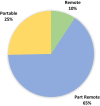Biomechanics beyond the lab: Remote technology for osteoarthritis patient data-A scoping review
- PMID: 36451804
- PMCID: PMC9701737
- DOI: 10.3389/fresc.2022.1005000
Biomechanics beyond the lab: Remote technology for osteoarthritis patient data-A scoping review
Abstract
The objective of this project is to produce a review of available and validated technologies suitable for gathering biomechanical and functional research data in patients with osteoarthritis (OA), outside of a traditionally fixed laboratory setting. A scoping review was conducted using defined search terms across three databases (Scopus, Ovid MEDLINE, and PEDro), and additional sources of information from grey literature were added. One author carried out an initial title and abstract review, and two authors independently completed full-text screenings. Out of the total 5,164 articles screened, 75 were included based on inclusion criteria covering a range of technologies in articles published from 2015. These were subsequently categorised by technology type, parameters measured, level of remoteness, and a separate table of commercially available systems. The results concluded that from the growing number of available and emerging technologies, there is a well-established range in use and further in development. Of particular note are the wide-ranging available inertial measurement unit systems and the breadth of technology available to record basic gait spatiotemporal measures with highly beneficial and informative functional outputs. With the majority of technologies categorised as suitable for part-remote use, the number of technologies that are usable and fully remote is rare and they usually employ smartphone software to enable this. With many systems being developed for camera-based technology, such technology is likely to increase in usability and availability as computational models are being developed with increased sensitivities to recognise patterns of movement, enabling data collection in the wider environment and reducing costs and creating a better understanding of OA patient biomechanical and functional movement data.
Keywords: biomechanics; gait; inertial measurement unit; osteoarthritis; remote technology.
© 2022 Hamilton, Williams, Consoritum and Holt.
Conflict of interest statement
The authors declare that the research was conducted in the absence of any commercial or financial relationships that could be construed as a potential conflict of interest.
Figures




Similar articles
-
Beyond the black stump: rapid reviews of health research issues affecting regional, rural and remote Australia.Med J Aust. 2020 Dec;213 Suppl 11:S3-S32.e1. doi: 10.5694/mja2.50881. Med J Aust. 2020. PMID: 33314144
-
Wearable Inertial Sensors for Gait Analysis in Adults with Osteoarthritis-A Scoping Review.Sensors (Basel). 2020 Dec 13;20(24):7143. doi: 10.3390/s20247143. Sensors (Basel). 2020. PMID: 33322187 Free PMC article.
-
Interventions to promote technology adoption in firms: A systematic review.Campbell Syst Rev. 2021 Nov 3;17(4):e1181. doi: 10.1002/cl2.1181. eCollection 2021 Dec. Campbell Syst Rev. 2021. PMID: 36950339 Free PMC article. Review.
-
Digital technologies in undergraduate and postgraduate education in occupational therapy and physiotherapy: a scoping review.JBI Evid Synth. 2020 May;18(5):863-892. doi: 10.11124/JBISRIR-D-19-00210. JBI Evid Synth. 2020. PMID: 32813350
-
Public sector reforms and their impact on the level of corruption: A systematic review.Campbell Syst Rev. 2021 May 24;17(2):e1173. doi: 10.1002/cl2.1173. eCollection 2021 Jun. Campbell Syst Rev. 2021. PMID: 37131927 Free PMC article. Review.
Cited by
-
Validation of 3D Knee Kinematics during Gait on Treadmill with an Instrumented Knee Brace.Sensors (Basel). 2023 Feb 6;23(4):1812. doi: 10.3390/s23041812. Sensors (Basel). 2023. PMID: 36850411 Free PMC article.
-
Novel Multi-View RGB Sensor for Continuous Motion Analysis in Kinetic Chain Exercises: A Pilot Study for Simultaneous Validity and Intra-Test Reliability.Sensors (Basel). 2023 Dec 5;23(24):9635. doi: 10.3390/s23249635. Sensors (Basel). 2023. PMID: 38139481 Free PMC article.
References
-
- OARSI. Osteoarthritis: a serious disease. Mount Laurel, USA: OARSI; (2016).
-
- Versus Arthritis. The state of musculoskeletal health 2021: arthritis and other musculoskeletal conditions in numbers. (2021).
Publication types
LinkOut - more resources
Full Text Sources
Miscellaneous

